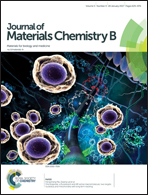Regulation of the adsorption selectivity of acidic or basic proteins using a polyoxometalate composite
Abstract
A novel polyoxometalate (POM)-based hybrid is prepared for the selective adsorption of acidic and/or basic proteins. The solidification of the POM moiety P8W48 is firstly achieved through dehydration condensation between the –OH group on the P8W48 surface and the Si–OH of aminopropyltriethoxysilane (APTS), and thereafter further condensation of the P8W48O184–APTS intermediate with poly(acrylic acid) (PAA) produces a hybrid, by linking carboxyl groups in PAA with –NH2 groups in P8W48O184–APTS via the formation of an amide bond. The P8W48–APTS–PAA hybrid surface is negatively charged due to abundant COO− groups from PAA, which provides electrostatic interactions with positively charged proteins by varying pHs. Meanwhile, the d–p π bond in P8W48 offers strong affinity to other proteins via π–π stacking interaction. The hybrid thus offers potential for achieving selective adsorption of either acidic or basic proteins by simply controlling the adsorption conditions, i.e., pH value or ionic strength of the adsorption medium. With ovalbumin (Ova) and lysozyme (Lys) as the models of acidic and basic proteins, their adsorption behaviors fit the Langmuir model, with adsorption capacities of 367.0 mg g−1 and 74.0 mg g−1, respectively. The retained proteins are readily recovered with 0.01 mol L−1 CTAB, providing recoveries of 89.0% for Ova and 93.0% for Lys. The P8W48–APTS–PAA hybrid is further applied for the isolation of Ova and Lys from real biological samples, egg white.



 Please wait while we load your content...
Please wait while we load your content...